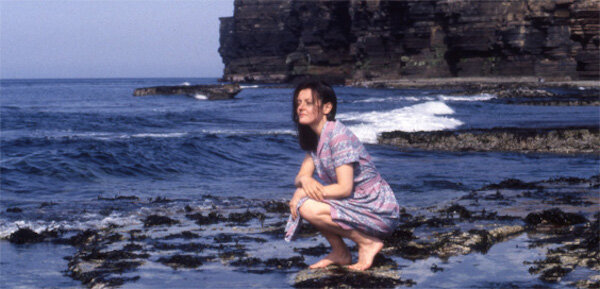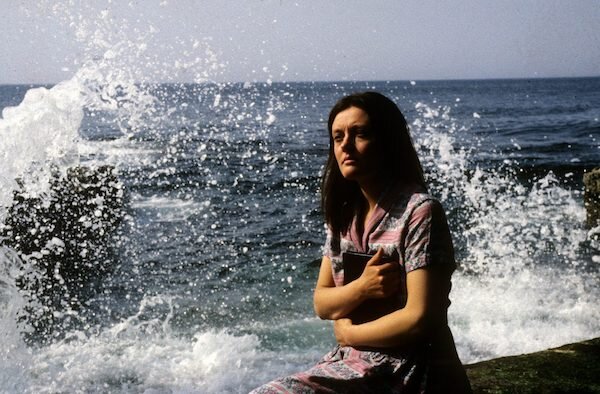The attentive, imaginative films of Margaret Tait changed the face of independent filmmaking – namely as she was the first Scottish woman to direct a feature-length film with her debut Blue Black Permanent. But there’s magic in the everyday, too. Iona Glen explores the legacy of trauma and female creativity through the prism of Tait’s relationship with Scottish folklore.
The sea encircles Margaret Tait’s Blue Black Permanent, filling the frame at the film’s open and close. Images of water seep into the narrative fabric. The camera lingers on light playing across the surface of the sea, white froth trails behind a boat making for the Orkney Islands, and a woman basks in a rainstorm as she walks down the long stone steps connecting Edinburgh’s Old and New Towns. Painted seascapes hanging in a family’s formal dining room are swept away by the next shot of real waves, roiling against stacks of rocks.
The sea is the inspiration for fictional poet Greta Kilday, who drowns off the coast of her native Orkney. Her death occupies the thoughts of her daughter Barbara, now an established photographer, who recounts her memories and the stories she has been told to her partner Philip. The film intersperses scenes of Greta’s life with those of her daughter coming to terms with the past and her own identity in the present.
Blue Black Permanent was Tait’s only feature-length film, and the first to be directed by a Scottish woman. She made over 30 films during her career in Edinburgh and Orkney, mostly self-funded. This work encapsulates the key themes of her filmography: the relationship between people and their landscapes, her love for Scotland, and the poetry of everyday things. Tait also documented women’s lives with quiet pride, as seen in Portrait of Ga, which builds up an affectionate picture of her elderly mother through observing her gestures, from the way she deftly unwraps a boiled sweet to how she rolls her cigarette.
Blue Black Permanent is a meditative portrayal of the intergenerational trauma created by the compromises that women have been forced to make while negotiating their domestic and artistic lives. Greta is like a selkie from Scottish folklore: seals who can become human and venture onto land. These stories are particularly strong on Orkney, where ‘selkie’ is simply the Orcadian word for seal. Although never connected explicitly in the narrative, there are striking parallels between Greta’s character and the story of the selkie wife. The tale has many variants – what follows is my own retelling:
On a full moon, seals remove their pelts to dance on the beach. A fisherman witnesses this and takes one of the sealskins. The owner is trapped, with no choice but to become the fisherman’s wife.
In Blue Black Permanent, Greta is sent away to school in Edinburgh by her parents. Her mother dies, swept off the rocks beside the Mermaid’s Cave she played in as a child. After World War Two, Greta marries a gentle, conventional man, and they have three children together.
The sealskin is hidden away in the attic, and the selkie tries to reconcile herself to life on land. Yet she longs for the sea. Her eyes and hair dry out, her skin peels.
Greta writes her poetry; a few pieces are published in magazines. Despite saying that she needs her homelife to ‘hold me down a bit’, she envies the untrammelled existence of her kindly artistic guru Andrew. He paints in his studio without distractions or inessentials, his work and need for solitude universally respected. Greta yearns to be an Orkney islander again. ‘I lost something when I left home,’ she tells her ill father when she visits him there.
One day the selkie’s curious child finds the old sealskin, mouldering and salt-reeking. She takes it to her mother. Immediately, the selkie puts on the skin and returns to the sea, leaving her family behind.
On holiday in Orkney, Greta and her children play on the beach. Barbara tells her mother to hold a shell to her ear and listen to the sound. ‘Yes, I do hear it, dear,’ Greta says, ‘I hear the sea.’ That night, she walks into the waves and drowns, whether accidentally or intentionally is left unresolved.
Folklorists suggest that animal bride stories like the selkie wife represent both humankind’s ambivalent relationship with nature and the ultimate unknowability of other people, however intimate you may be. Yet I also see the stolen sealskin as a representation of a person’s creative power. Its theft is a metaphor for the societal constraints placed on women and their art, which entraps them just like the selkie in a captive marriage. This creates a traumatic legacy: Barbara is the selkie child that Greta leaves behind, and she remains haunted by that loss.
I do not mean to present a dichotomous picture of creativity and domesticity as inherently incompatible. The model Andrew represents is over-mythologised, although Tait’s grounded depiction manifests as a simple dedication to craft rather than the solipsistic behaviour beloved of so many portraits of the male artist. But viewing Greta’s character through the prism of the selkie story reflects just how much poetry is her sustaining force. The effects of her separation from Orkney and her pelagic element is a wound inflicted not just on her but on everyone: her family and potential readership. Her work is scattered and ignored. Barbara is not even sure whether her mother’s notebooks were kept when her father moved house; she herself possesses only one handwritten poem that Andrew gave to her. Throughout history, women’s work has not been preserved and remembered consistently. Although many sea-crossings have been made, the traces of the vessels’ passage are lost, swirled back into the massed body of water. Too many selkie-women are marooned.
In a beautifully ambiguous sequence, Greta’s family enters her writing room at the holiday cottage after her death, invoking Virginia Woolf’s famous image of the ‘room of one’s own’ necessary for women who write. Her desk is set before the window with a view of the sea, a piece of paper left out. Picking it up, the children’s father tells them it is a poem. But he doesn’t read aloud, folding the page into his jacket pocket. Is it a suicide note he is sparing them from? Or is this the first posthumous silencing of Greta’s poetic voice? Decades pass before Barbara visits the National Library to look for Greta’s work in the archives.
There are several long shots of Greta’s writing desk at the end of the film, its paraphernalia stirred by wind coming through the open window. Objects are important in Tait’s films, traces of physical presence, suggestive biographies of their owners. A bottle of Quink ink is set on the desk. It is the same ‘blue black permanent’ that Tait used to write her own poetry, the same blue black permanent of the sea. Tait stated that her vision of the film was ultimately optimistic despite its tragedy, showing the ‘persistence of the spirit’, the spirit of place, culture, and ‘the creative person at the centre.’ Greta’s poetry and the sea surrounding Orkney are the same substance, just like the selkie and her recovered sealskin. The last sequences of the film pull slowly from land to sea, from images of the pebbled beach to seaweed-strewn sand, from the waves nibbling at the shore to the water’s greater depths, and the horizon just beyond.
Iona Glen is a writer and museum visitor services assistant living in London.



